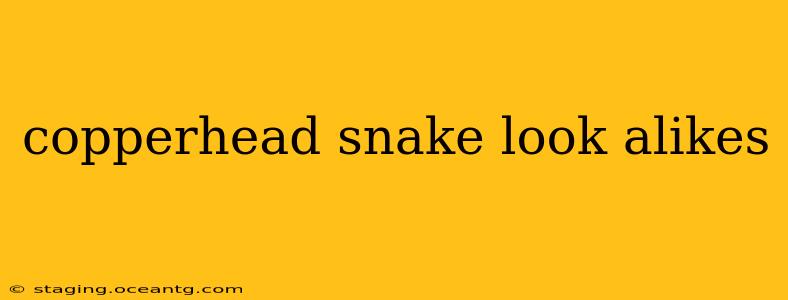Copperhead snakes, with their distinctive hourglass-shaped markings, are found throughout eastern North America. However, several other snakes share similar coloration and patterns, leading to frequent misidentification. Knowing how to differentiate a copperhead from its look-alikes is crucial for safety and responsible wildlife observation. This guide will help you understand the key differences between copperheads and their most common non-venomous mimics.
What Snakes Look Like Copperheads?
Several species can be mistaken for copperheads, particularly for those unfamiliar with snake identification. These include, but are not limited to:
-
Eastern Hognose Snake: These snakes are masters of deception. They often flatten their heads and hiss aggressively, mimicking the appearance and behavior of a venomous snake. While their coloration can vary, some individuals exhibit brown or reddish-brown markings that vaguely resemble a copperhead's hourglass pattern. However, the hognose's markings are typically less defined and lack the sharp contrast found in copperheads. Their upturned snout is also a distinguishing feature.
-
Eastern Ratsnake (Black Ratsnake): While typically dark gray or black, juvenile Eastern Ratsnakes can sometimes have reddish-brown coloration and blotches that might be confused with a copperhead's pattern. However, these markings are often less regular and lack the distinct hourglass shape. Adults are easily distinguishable due to their size and lack of hourglass pattern.
-
Red-Bellied Snake: This small, slender snake has a reddish-orange belly, hence its name. Some individuals can have brown dorsal markings that might be mistaken for a copperhead's pattern at a quick glance. However, their markings are generally less defined and their overall body shape is quite different from a copperhead.
-
Brown Snakes (Various Species): Several species of brown snakes, depending on their location and age, may exhibit coloration that superficially resembles a copperhead. Close examination of the head shape, body shape, and pattern details are vital to differentiate between them.
How to Tell the Difference Between a Copperhead and its Look-Alikes?
Accurate identification requires careful observation and attention to detail. Here's a breakdown of key characteristics to distinguish a copperhead from its imitators:
Head Shape: Copperheads possess a triangular, broad head distinct from their neck, unlike the more rounded heads of many non-venomous snakes.
Hourglass Pattern: The copperhead's defining characteristic is its pattern of dark, reddish-brown, hourglass-shaped markings on a lighter background. While some look-alikes might have blotches, the copperhead's pattern is consistently distinct and well-defined.
Pupil Shape: Copperheads have elliptical pupils, whereas many non-venomous snakes have round pupils.
Body Shape and Size: Copperheads are relatively stout-bodied snakes. Comparing the body's overall shape and size with known characteristics of similar snakes in your area can help in differentiation.
Are there any other snakes that might be mistaken for copperheads?
Yes, several other less common snakes might superficially resemble a copperhead, depending on their coloration and geographic location. It's crucial to consult regional field guides and reputable resources for accurate identification in your specific area.
What should I do if I see a snake that looks like a copperhead?
Do not attempt to handle it. Observe it from a safe distance and consult resources to help you identify it. If you are concerned that it may be a copperhead and pose a threat, contact local wildlife control or your state's wildlife agency.
How can I learn more about snake identification?
Several resources are available to assist in snake identification. Local herpetological societies, field guides specific to your region, and online resources with high-quality images and descriptions are invaluable tools. Remember that reliable identification often requires careful observation and familiarity with local snake species.
This information is for educational purposes only and should not be considered a substitute for professional identification. Always prioritize safety when encountering snakes.
